Abstract
The general variable coefficient cylindrical/spherical KdV equation has been investigated by using the simplified homogeneous balance method. It has been proven that if its coefficients satisfy certain constraint conditions, then the cylindrical/spherical KdV equation has a nonlinear transformation that converts the solution of the quadratic form equation into the solution of the cylindrical/spherical KdV equation. The quadratic form equation admits a series of solutions expressed by the exponential functions, therefore one soliton-like solution and multi soliton-like solutions of the cylindrical/spherical KdV equation can be obtained exactly.
Keywords:
variable coefficient cylindrical/spherical KdV equation; nonlinear transformation; quadratic form equation; soliton-like solution; multi soliton-like solution; simplified homogeneous balance method MSC:
35Q51
1. Introduction
In the present paper we investigate general variable coefficient cylindrical/spherical KdV equation [1,2,3] in the form
where is the nonlinear coefficient and is the dispersion coefficient. The last term containing an arbitrary and positive integer “m” represents the geometry effects: when , it represents the cylindrical geometry effect, and Equation (1) is called the cylindrical KdV equation; when , it represents the spherical geometry effect, and Equation (1) is called the spherical KdV equation.
In Ref. [4], by using the conventional reductive perturbation method, the authors derived the cylindrical (spherical) KdV and mKdV equations and obtained the progressive wave solutions. Through the use of the reductive perturbation method, an approximate analytical method for the progressive wave solution is presented for the cylindrical (spherical) KdV and the modified KdV equations in the sense of the weighted residual method in Ref. [5]. Although several researchers derived these evolution equations for various type of plasma structures, there is no analytical progressive soliton-like solution available, especially for the general variable coefficient cylindrical/spherical KdV equation.
The question considered in the paper is to find out what constraint condition exists for and , such that Equation (1) admits an exact soliton-like solution, as well as exact multi soliton-like solutions. We shall apply the simplified homogeneous balance method (SHB) [6,7,8,9,10], different from the homogeneous balance method (HB) [11,12,13], to investigate Equation (1), thereby to answer this question. By this method, a nonlinear transformation from the solution for a quadratic form equation to the solution for the general variable coefficient cylindrical/spherical KdV equation is derived, and one soliton-like solution and multi soliton-like solutions are obtained via the nonlinear transformation successfully. It is worth noting that these solutions have not been mentioned in the previous literature. The geometric shapes of some soliton-like solutions are studied by numerical simulation. The constraint condition of a solution for a variable coefficient is discussed and the comparison of the influence of parameters on its shape is investigated.
2. Derivation of Constraint Condition and Nonlinear Transformation
Considering the homogeneous balance between and in Equation (1) () according to the simplified homogeneous balance method, we can suppose that the solution of Equation (1) is of the form
where we use instead of the undetermined functions appearing in the homogeneous balance method to simplify the original HB; functions and are to be determined later. The aim of the simplified HB is to find the variable coefficient and the function , such that the expressions (2) exactly satisfy Equation (1).
From (2) it is easy to obtain that
Substituting (2)–(5) into the left hand side of Equation (1) and collecting all terms with together, yields
In (6), setting the coefficient of and the coefficient of to zero, yields
Solving the first equation in (7) yields
Substituting (8) into the second equation in (7), we obtain
which is the constraint condition for and .
Substituting (8) into (2) yields
Using (7) and (8), the expression (6) can be simplified as
provided that satisfies the quadratic form equation
Using (9)–(12), we come to the conclusion that is the theorem in the following.
Theorem 1.
Ifandin Equation (1) satisfy the constraint condition (9),is the solution of the quadratic form Equation (12), then the expression (10) satisfies Equation (1) exactly.
Theorem 1 shows that the expression (10) and the quadratic form Equation (12) together have comprised the nonlinear transformation for Equation (1)
provided that and satisfy the constraint condition (9).
By the nonlinear transformation, the problem to solve Equation (1) becomes the one to solve the quadratic form Equation (14). In the next section, a series of solutions of Equation (14) will be given, then a soliton-like solution and multi soliton-like solutions of Equation (1) can be obtained.
3. Soliton-Like Solutions of Equation (1)
Using the -expansion method [14], or Hirota’s method [15], a series of solutions of Equation (14) can be obtained as follows:
……
where indicates the summation over all possible combinations of , while indicates the summation over all possible combinations of and from to subject to .
Substituting the solution of Equation (14) into the expression (13), we have one soliton-like solution of Equation (1) as follows:
The amplitude of is and the velocity of is Both amplitude and velocity are all changed with the variable .
Substituting the solution of Equation (14) into the expression (13), we have two soliton-like solutions of Equation (1) as follows:
.....
Substituting into (13), we have soliton-like solutions as:
where and satisfy expression (9), which is the following relationship:
4. An Example
Consider the cylindrical/spherical KdV equation in the form [16]:
where is an arbitrary analytical function, in view of
Thus, based on the theorem in Section 2, Equation (15) has a nonlinear transformation expressed as (16) and (17):
Equation (17) admits a series of solutions as follows:
……
Substituting into expression (16), respectively, then one soliton-like solution (Figure 1), two soliton-like solutions (Figure 2 and Figure 3), and three soliton-like solutions (Figure 4 and Figure 5) can be obtained, respectively, as follows:
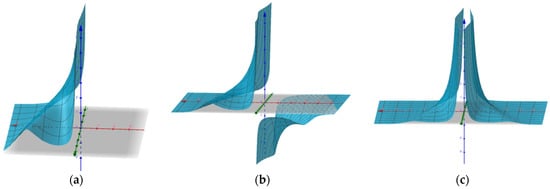
Figure 1.
For the one soliton-like solution , when , the corresponding graphs of and are given as above. ; ; .
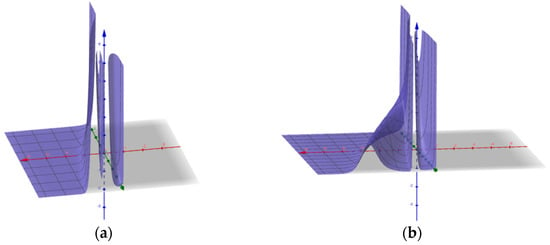
Figure 2.
For the two soliton-like solution , when , the corresponding figures of and are given as above. ; .
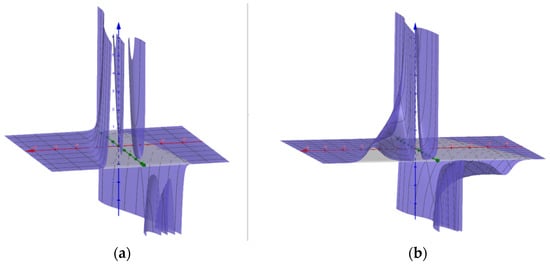
Figure 3.
For the two soliton-like solution , when , the corresponding figures of and are given as above. ; .
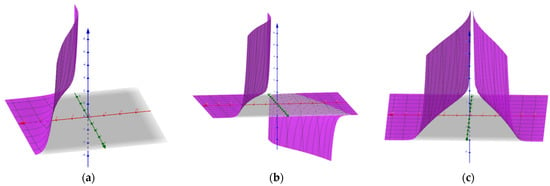
Figure 4.
For the three soliton-like solution , when , the corresponding graphs of and are given as above. ; ; .
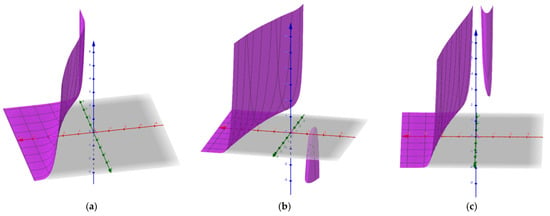
Figure 5.
For the three soliton-like solution , when , the corresponding graphs of and are given as above. ; ; .
The comparison of different geometric structures of solitons clearly shows that for and , fixed and , and different parameters are selected, the soliton solution morphology changes little. However, for , when is different, the soliton solution will fluctuate greatly.
5. Conclusions
The general variable coefficient cylindrical/spherical KdV equation in the form
has been investigated by using the simplified homogeneous balance method. The results obtained in this paper are that if and satisfy the constraint condition
i.e., then Equation (18) has a nonlinear transformation, as follows
The quadratic form Equation (21) admits a series of solutions, as follows
……
Thus, substituting (i = 1,2,3,…) into expression (20), respectively, one soliton-like solution and multi soliton-like solutions of Equation (18) can be obtained.
In particular, when m = 1 and m = 2, soliton-like solutions of the general variable coefficient cylindrical/spherical KdV equation, that is the particular case of Equation (18), are also successfully obtained. The results obtained in this paper are different from those reported earlier. The simplified homogeneous balance method is also applicable to other nonlinear differential equations.
Author Contributions
Investigation, L.L.; methodology, M.W.; writing—original draft preparation, L.L. All authors have read and agreed to the published version of the manuscript.
Funding
This work is supported in part the National Natural Science Foundation of China (Grant No. 12101193) and the Higher Education Teaching Reform Research and Practice Project in Henan Province (Grant no. 2021SJGLX381).
Institutional Review Board Statement
Not applicable.
Informed Consent Statement
Not applicable.
Data Availability Statement
Not applicable.
Conflicts of Interest
The authors declare no conflict of interest.
References
- Javidan, K. Cylindrical and spherical ion acoustic solitary waves in electron positron-ion plasma with super thermal electrons. Astrophys. Space Sci. 2013, 343, 667–673. [Google Scholar]
- Xue, J. Cylindrical and spherical ion acoustic solitary waves with dissipative effect. Phys. Lett. A 2004, 322, 225–230. [Google Scholar]
- Sahu, B.; Roychoudhury, R. Exact solutions of cylindrical and spherical dust ion acoustic waves. Phys. Plasma 2003, 10, 4162–4165. [Google Scholar] [CrossRef]
- Essam, R.E.-Z.; Demiray, H. Analytical solutions of cylindrical and spherical dust ion-acoustic solitary waves. Results Phys. 2019, 13, 102154. [Google Scholar]
- Demiray, H. Analytical solution for nonplanar waves in a plasma with q-nonextensive nonthermal velocity distribution: Weighted residual method. Chaos Solitons Fractals 2020, 130, 109448. [Google Scholar] [CrossRef]
- Wang, M.L.; Li, X.Z. Simplified homogeneous balance method and its application to Whitham-Broer-Kaup model equations. J. App. Math. Phys. 2014, 2, 823–827. [Google Scholar] [CrossRef]
- Wang, M.L.; Zhang, J.L.; Li, X.Z. Decay mode solutions of cylindrical KP equation. Appl. Math. Lett. 2016, 62, 29–34. [Google Scholar] [CrossRef]
- Wang, M.L.; Zhang, J.L.; Li, X.Z. N-dimensional auto-Backlund transformation and exact solutions to N-dimensional Burgers system. Appl. Math. Lett. 2017, 63, 46–52. [Google Scholar] [CrossRef]
- Wang, M.L.; Li, X.Z.; Zhang, J.L. Two soliton solution to generalized KP equation with general variable coefficients. Appl. Math. Lett. 2018, 70, 21–27. [Google Scholar] [CrossRef]
- Zhang, J.L.; Wang, M.L. Decay mode solution of nonlinear boundary–initial value problems for the cylindrical (spherical) Boussinesq-Burgers equations. Appl. Math. Lett. 2019, 89, 50–57. [Google Scholar] [CrossRef]
- Wang, M.L. Solitary Wave Solutions for Variant Boussinesq Equations. Phys. Lett. A 1995, 199, 169–172. [Google Scholar] [CrossRef]
- Wang, M.L. Exact Solutions for a Compound KdV-Burgers Equation. Phys. Lett. A 1996, 213, 279–287. [Google Scholar] [CrossRef]
- Wang, M.L.; Zhou, Y.B.; Li, Z.B. Application of a Homogeneous Balance Method to Exact Solutions of Nonlinear Equations in Mathematical Physics. Phys. Lett. A 1996, 216, 67–75. [Google Scholar] [CrossRef]
- Wang, M.L.; Zhang, J.L.; Li, E.Q.; Xin, X.F. The Generalized Cole-Hopf Transformation to A General Variable Coefficient Burgers Equation with Linear Damping Term. Appl. Math. Lett. 2020, 105, 106299. [Google Scholar] [CrossRef]
- Wang, M.L.; Zhang, J.L.; Liu, Z.G.; Li, E.Q. Soliton-like solutions of general variable coefficient (2+1)-dimensional KdV equation with linear damping term. Appl. Math. Lett. 2022, 129, 107929. [Google Scholar] [CrossRef]
- Ablowitz, M.J.; Segur, H. Solitons and the Inverse Scattering Transform; SIAM: Philadelphia, PA, USA, 1981. [Google Scholar]
Publisher’s Note: MDPI stays neutral with regard to jurisdictional claims in published maps and institutional affiliations. |
© 2022 by the authors. Licensee MDPI, Basel, Switzerland. This article is an open access article distributed under the terms and conditions of the Creative Commons Attribution (CC BY) license (https://creativecommons.org/licenses/by/4.0/).